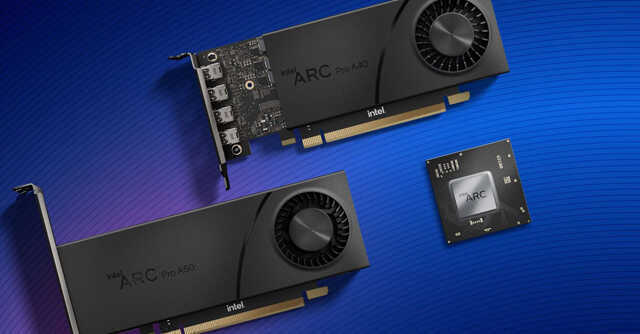
Intel launches GPUs for engineering, manufacturing design on workstation PCs


Chipmaker Intel has been eyeing the global graphics processing unit (GPU) market with its new Arc GPU portfolio. The company has now officially forayed into the workstation GPU market, announcing two new GPUs for workstation desktops, and one for workstation laptops. While you can technically also game using these GPUs, the new Arc Pro chips are meant for industrial design in fields such as engineering, construction, graphic designing and manufacturing.
Intel’s latest portfolio includes the Arc Pro A30M GPU for workstation laptops, and A40 and A50 GPUs for workstation desktops. Of the two desktop GPUs, the A40 is a single-slot GPU that is designed for compact, small workstation desktops — with small, portable cabinets.
Intel said that all of its Arc Pro GPUs are capable of artificial intelligence-driven ray tracing graphics rendering, and AV1 hardware acceleration. Ray tracing improves the rendering of directional light and shadows, which could be immensely beneficial for industrial designing. AV1, meanwhile, is a leading industry standard for compression of heavy graphics files. While it offers the best compression results, it is also heavy on resources — and is, therefore, a key factor for workstation PCs to consider.

Workstation GPUs have always differed from the mainstream gaming GPUs in the way they work. While gaming GPUs prioritise frame rates being rendered on screen for smoothness of gameplay, workstation GPUs prioritise fidelity and accuracy of graphics, which is crucial in industrial design and applications.
Nvidia and AMD, the market leaders in the global consumer and enterprise GPU market, already offer dedicated GPU portfolios — while Nvidia has its Quadro and RTX A-series on offer for workstation PCs, AMD offers Radeon Pro.
Intel added that its peak offering in the Arc Pro series right now, the A50, is compatible with two 8K 60fps displays at the same time, or two 5K 120fps displays, or even four 4K 60fps displays. Its graphic performance is, on paper, higher than the Nvidia RTX 3060 mid-range consumer GPU.

